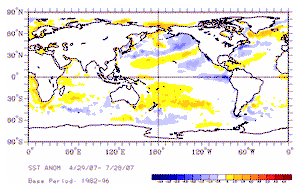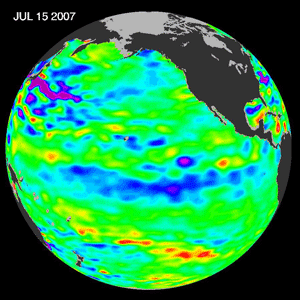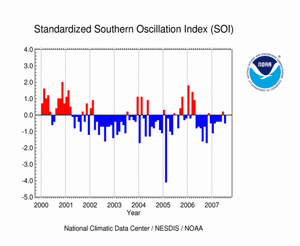NEUTRAL PHASE OF ENSO PERSISTS:
COOLING SSTs INDICATE THE POSSIBLE DEVELOPMENT OF LA NIÑA
COOLING SSTs INDICATE THE POSSIBLE DEVELOPMENT OF LA NIÑA
|
|
Sea-Surface Temperatures
(SSTs) and
Mixed-Layer Conditions: Equatorial Pacific Ocean surface and subsurface temperatures have been near or slightly cooler-than-average over the past several months, as the phase of ENSO was neutral. During July, the SSTs decreased across the equatorial Pacific region, as a weak Kelvin wave propagated across the basin. Water temperatures in the mixed-layer remained below normal, with an area of -2.0°C (-3.6°F) and cooler temperature anomalies between 100-200 meters depth in the central and eastern equatorial Pacific. Warmer-than-average upper ocean temperatures remained in the far western equatorial Pacific west of the Date Line in July. For the month, the SST anomaly in the Niño 3.4 Index region was -0.29°C (-0.52°F), which was a decrease of -0.38°C (-0.68°F) compared to the June value. The SSTs in the Niño 4 Index region of the western equatorial Pacific also decreased slightly during July, which resulted in a monthly anomaly of 0.05°C (0.09°F) above the mean (map of Niño regions). For the most recent global ocean surface temperatures, please see the loop of satellite-derived weekly SST anomalies for July 2007. The cooling of the SST anomalies in the Niño 3.4 index region over the past several months decreased the 3-month running mean below the long-term average during July. (NOTE: For NOAA's official ENSO classification scheme, please see NOAA's El Niño/La Niña Index Definition). The NOAA Climate Prediction Center's most recent ENSO Diagnostic Discussion indicated that the current phase of ENSO was neutral, while the latest ENSO update from the Australian Bureau of Meteorology (BoM) also reflected the ENSO-neutral conditions in the equatorial Pacific basin. Both CPC and the BoM have indicated a slightly greater than 50% chance of a La Niña event developing over the next 1-3 months (see the Australian BoM ENSO Wrap-Up). |
|
|
Equatorial Zonal
Winds (U-Component Winds) and Sea-Level Topography: The easterly Trade winds were above normal across most of the equatorial Pacific during July. The observed strengthening of easterly winds along the equatorial zone increased upwelling in the mixed-layer, which is an essential factor in the development of La Niña conditions. Significant week-to-week variability in the near-surface winds has been observed along the equatorial region of the Pacific, as shown in the animation of July zonal winds. Periods of above normal westerly flow occurred across parts of the eastern equatorial Pacific region during early July, as the easterly Trade winds were below-average off the South American coast. Pacific sea levels measured by the NASA/JPL Jason-1 satellite remained below average across the central equatorial Pacific, reflecting the cooling ocean surface temperatures in this region (see the most recent image of 15 July 2007 sea level anomalies). |
|
|
Outgoing
Longwave Radiation (OLR): The map to the left shows the spatial pattern of global OLR (in W m-2) measured by satellite during July. An area of positive OLR anomalies was observed in the eastern Pacific just north of the equator along the Inter-Tropical Convergence Zone (ITCZ). Positive OLR anomalies along the equator in the eastern Pacific were also observed over the past 3 months (May-July) as well. The persistence of positive OLR anomalies due to suppressed tropical convection along the equatorial zone in the central and eastern Pacific is a common signal associated with La Niña conditions. The monthly OLR index for July was +1.1 W m-2 averaged across an area in the western Pacific near the Date Line between 160° E and 160° W. Therefore, the July value of the OLR Index increased significantly, reflecting that a transition from neutral ENSO toward La Niña conditions is possible over the next 1-3 months. Note: high frequency variability in OLR is typically associated with the Madden-Julian Oscillation (MJO), which is an intra-seasonal oscillation in convective activity that propagates west to east in the near-equatorial region from the Indian Ocean into the Pacific Ocean approximately every 30-60 days. The latest MJO activity can be seen in CPC's graphs of Daily MJO Indices. |
| Southern
Oscillation Index (SOI): The standardized value of the SOI was -0.5 in July. Despite a brief excursion to a positive SOI in June, seven of the previous eight months have had negative SOI values [consistently negative (positive) values of the SOI are typical of El Niño (La Niña) conditions]. Therefore, the SOI has been inconsistent with other atmospheric and oceanic indicators over the past several months, and during July the SOI was indicative of an El Niño-type sea level pressure pattern across the equatorial Pacific basin. |
Additional Links
- ENSO Monitoring
- NOAA El Niño / La Niña Index Definition
- NOAA's Pacific Marine Environmental Laboratory (PMEL):
- NOAA's Climate Prediction Center (CPC):
- NOAA's Physical Science Laboratory
- NASA/JPL Ocean Surface Topography from Space
- Australian Bureau of Meteorology (BoM) Climate Driver Update
- IRI - International Research Institute
 NOAA's National Centers for Environmental Information
NOAA's National Centers for Environmental Information






 Larger image of
July OLR Anomalies
Larger image of
July OLR Anomalies Larger image
of May-July OLR Anomalies
Larger image
of May-July OLR Anomalies Larger image of July
OLR Index
Larger image of July
OLR Index